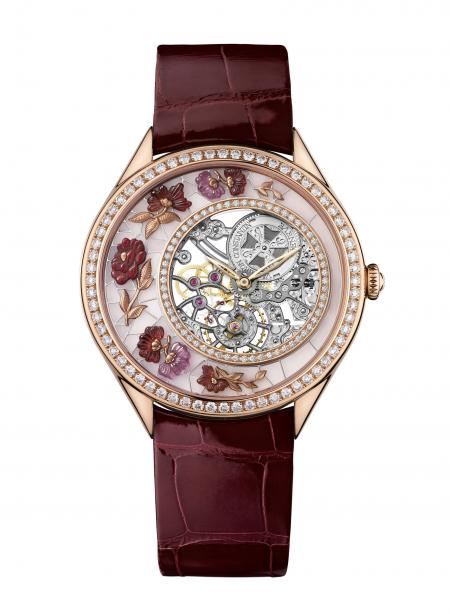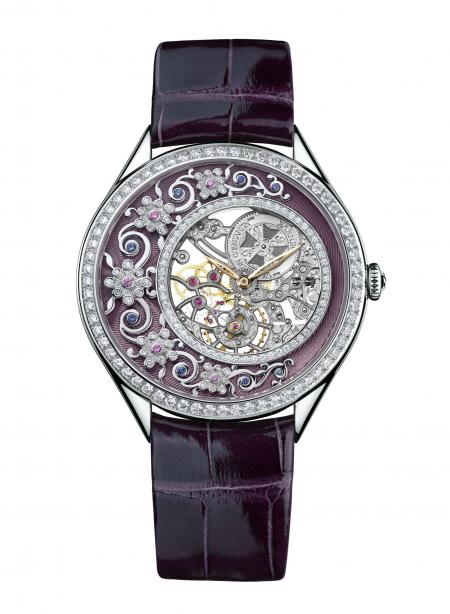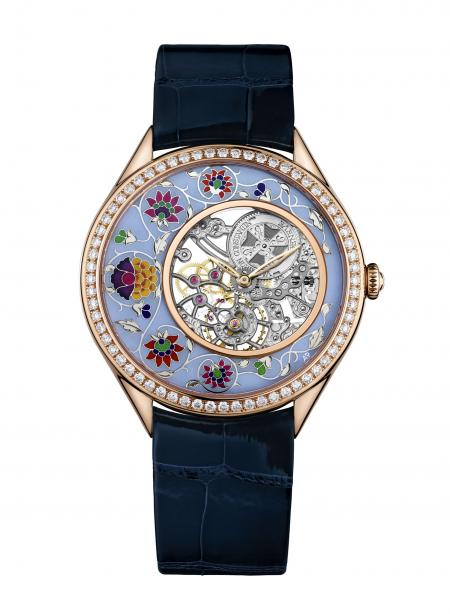SIHH 2014 – Novelty Vacheron Constantin : Métiers d’Art Fabuleux Ornements
By MyWatch
The new Métiers d’Arts Fabuleux Ornements collection is an irresistible invitation to embark on a journey celebrating the ornamental beauties of the world drawn from the decorative arts of several cultures. Inspired by dreams of faraway places and by the open-minded approach to the world consistently cultivated by Vacheron Constantin, it unveils four ladies’ models born of the art of openworking and a combination of artistic crafts. Ten different master artisans have taken turns in providing talented reinterpretations of Ottoman architecture, Chinese embroidery, Indian manuscripts and French lacework. These exquisitely feminine creations are equipped with an ethereal hand-engraved calibre echoing the precious dial ornamentation and enshrining a subtle blend of inner and outer beauty.
Journey to the heart of technical and precious ornamentation
One of the most fascinating facets of a woman’s nature is her ability to reinvent herself while remaining keenly attentive to the world around her and its manifold cultures. Vacheron Constantin has repeatedly exercised boundless creative freedom through incredible creations dedicated to women. These naturally include wristwatches, but prior to that there were richly ornamented pocket watches worn on sautoir necklaces, suspended from a chain in chatelaine mode, pinned to a dress or hidden inside a brooch. All of them call upon the imagination nurtured by the artisans of the Manufacture – master-watchmakers as well as engravers, enamellers, guillocheurs, jewellers and gem-setters – in order to meet the expectations of an ever more discerning clientele.
The Métiers d’Art Fabuleux Ornements watches invite women to rediscover the beauty of the ornaments of the world, beating to the rhythm of a precious and technical watch calibre. China and its ancient embroideries, India and its colourfully illustrated manuscripts, the Ottoman empire and its architecture, France and its lacework: all are sources of inspiration conveying their art through gossamer-light compositions exalted by the artisans of the Manufacture. Guillochage, Grand Feu enamel, diamonds, pearls and mother-of-pearl, as well as engraving, glyptics and gemstone cloisonné effects: traditional arts at the crossroads between various cultures spring to life, in step with the oscillations of an exquisitely airy hand-engraved calibre.
A precious openworked calibre: when a mechanism becomes an adornment as fine as ornaments themselves.
“No external grace is complete if it is not vivified by inner beauty”. These words written by Victor Hugo are perfectly echoed in the Métiers d’Art Fabuleux Ornements collection, in which the openworked and engraved calibre makes a perfect match for the dial ornamentation.
A masterful demonstration of Vacheron Constantin’s expertise in the field of decoration, the openworking of the ultra-slim Calibre 1003 in 18K gold – a mere 1.64 mm thin – transform it into an incredible lacework of engraved wheel trains. The feat consists in withdrawing a maximum of material without affecting the vital parts that ensure the smooth running of the watch. Setting the final touch to the work, all the bridges are hand-drawn with a file, while every single part is patiently hand-chamfered, decorated and fashioned in traditional manner to form an ideally feather-light composition. The finesse of the front-facing décor is precise to the nearest tenth of a millimetre, while on the back Vacheron Constantin has opted for an exclusively chamfered and hand-drawn finish that preserves a pure, restrained appearance.
Métiers d’Art Fabuleux Ornements – India manuscript
Grand Feu champlevé enamelling and hand engraving
Framed by a pink gold case topped by a diamond-set bezel, ten vibrant enamel colours blossom on the dial. These shimmering shades form oriental-inspired flowers blooming against a blue sky. The master-enameller has expressed the vivacity and richness of Indian illustrations through a profusion of intense enamels surrounding the openworked calibre, like the floral motifs decorating the margins of ancient oriental writings. The contours of its décor are first traced using the champlevé technique to create cavities separated by thin gold partitions in order to apply the enamels. These ten different hues represent a daunting challenge in terms of mastering the successive firings, a process that calls for a true alchemist’s skill. The foliage, which is meticulously hand-engraved after enamelling, heightens the radiance of the watch and echoes the engraving of the openworked calibre. This is one of the most delicate stages, since even the slightest slip of the hand can jeopardise the entire creation.
Métiers d’Art Fabuleux Ornements – Ottoman architecture
Chamfering, mother-of-pearl, and half-pearl beads
The ethereal calibre is magnificently reflected by the chamfered pink gold moucharaby (wooden lattice) motif formed by the dial and of which every edge is delicately bevelled by hand. Daintily perched on a natural white mother-of-pearl base, the gold gridwork studded with half-pearl beads echoes the majesty of the scrolling patterns in Middle Eastern architecture. The meticulously executed decoration on the rings, known as milgrain and featuring strings of tiny bead shapes coined along the edges, add to the magic of the workmanship. The enchanted world of the Arabian nights continues in the arabesques of the calibre, also embellished with engravings.
Métiers d’Art Fabuleux Ornements – French lacework
Guillochage, Grand Feu enamelling and gem-setting
A luminous white gold lacework adorns the translucent hand-guilloché Grand Feu enamelled dial. This artfully polished spun lace pattern is reminiscent of the grand tradition of French-style embroideries, an ancestral art ingrained in the national culture. An infinite sense of lightness pervades the scene, evoking the patient and dextrous craftsmanship performed with the crochet needle or the spindle. The base of the gold dial is clad in a guilloché motif lending subtle depth to the transparent enamel.
Métiers d’Art Fabuleux Ornements – Chinese embroidery
Glyptics, gemstone cloisonné work and engraving
Crafted in pink gold according to the cloisonné technique, the dial is carpeted with flowers in rubies, cuprites and garnets. Like the silk thread Chinese embroideries embellished with precious fabrics, the graceful elegance of the stones cut and sculpted according to the glyptic art are adorned with finely engraved gold leaves and pistils. Concern for detail taken to extremes, as epitomised in the veins of the plants and the rounded shape of the petals, endow this ornamentation with a fascinating depth effect. The particularly delicate ruby engraving is a true challenge. The pink opals are individually cut and lapped to form a tapestry of stones on a dial prepared for this purpose with barely 0.5 mm thin white gold partitions. The impressive finesse of the work accomplished by the master lapidaries and engravers pays a vibrant tribute to the traditional art of embroidery exercised for millennia in China.
Creations bearing the Hallmark of Geneva
The Métiers d’Art Fabuleux Ornements watches bear the prestigious Hallmark of Geneva. Instated by the Grand Council of the Republic and Canton of Geneva in 18i86, the Hallmark is a guarantee of provenance, durability and expertise. This quality label of independent origin and with no true equivalent underwent a fundamental transformation in 2011: since then, the certification no longer applies to the calibre alone, but to the timepiece as a whole – a major evolution for this token of fine craftsmanship that enjoys the longstanding support of Vacheron Constantin.
The art and technique of openworking
Far more than a mere object of mechanical excellence indicating the time, a timepiece by Vacheron Constantin is by essence destined to be a full-fledged work of art capable of revealing all the beauty of unique expertise enriched by over 260 years of history. Ever since its founding in 1755, the Manufacture has consistently enhanced the beauty of its creations through artistic crafts exercised by skilled artisans. Hand engraving is one such technique. A demanding art calling for exceptional patience and dexterity, it was used right from the start as a means of achieving ethereal lightness. The first watch created by Jean-Marc Vacheron in 1755 already featured an openworked and engraved balance-cock. The quest for transparency then continued, with increasingly finely fashioned mechanical parts, leading to the creation in 1924 of the first entirely openworked calibre beating at the heart of a pocket watch. A past master in the practice of this extremely intricate discipline, Vacheron Constantin has given free rein to its creativity, progressively openworking both simple and complicated calibres, associating them according to its inspiration with other artistic crafts, and interpreting these miniature marvels both on pocket-watches and wristwatches from the 1960s onwards.
Not content with being one of the rare manufacturers capable of openworking such complex calibres as minute repeaters, perpetual calendars and tourbillons, Vacheron Constantin once again pushes the boundaries of its art by reinventing both the technique itself and the aesthetic codes governing it. The engraving thus becomes a sculpture, as the straight lines morph into interlacing curves, while the watch parts become architectural works creating mesmerising light effects.
Openworking, or the art of transparent and ethereal mechanical magic
The all-important initial touch of the watchmaker
While openworking is a purely aesthetic approach in itself, it nonetheless induces additional complexity at each stage compared with a solid calibre. Everything begins with a lengthy consideration of the movement that is to be openworked as much as possible so as to reveal its inner beauty. This calls upon the full wealth of experience of the finest master-watchmakers, since it involves achieving a subtle balance between hollowing out as much of the material as possible, while ensuring that the calibre remains perfectly functional. The conceptualisation, design and modelisation phases take several hundred hours, a figure that increases in step with the level of sophistication of the calibre, particularly in terms of complications.
Enter the artisans
Once this subtle balance has been found, the artisans take over, marking the start of a long period of patient, accurate and rigorously disciplined endeavours. The mainplate, bridges, barrel and other mechanical parts that have been previously drilled and cut out occupy their nimble fingers for dozens of hours until they are ready to reveal their appealing new face. Working by hand with each component in turn, the artisans create subtle contrasts between the finished polish of the chamfering that will catch the light, and the matt effect of the hand-drawing that will accentuate the radiance. While this is in itself a demanding task, it is rendered even more complex by the curved openings and interior angles – some narrower than 45° – favoured by Vacheron Constantin in its openworked creations, and which no machine could possible reproduce.
The chamfering and hand-drawing are followed by the engraving itself. For around one full week for each calibre, the engraver incises and sculpts the material with meticulous strokes of the burin in order to create the original motifs imagined by Vacheron Constantin, giving them their delightfully rounded relief. Each gesture is highly accurate – in some cases to the nearest tenth of a millimetre – and the aesthetic sensitivity of the artist-artisan is finely attuned to instilling each component with unique character.
Back to the workbench
Assembling and adjusting an openworked calibre is a particularly complex task, since the loss of material resulting from the openworking inevitably leads to certain distortions of the parts. For the watchmaker, this means retouching them again and again until their impeccable interaction is guaranteed. Throughout this lengthy process, he makes sure that no dust settles in the hollowed-out surfaces, and also carefully complies with the
extremely stringent standards imposed by the Hallmark of Geneva. He devotes special attention to each part, notably the chamfered parts, so as to ensure their perfect aesthetic and functional execution. This perfection is once again severely tested when casing up the movement, since the transparency stemming from the openworking highlights every single perfection, however tiny. Well before the start of the long sequence of water-resistance, reliability and precision testing begins, the calibre returns several times to the workbench until the full magic of a masterfully executed openworked movement begins to weave its spell. Just as as in other fields, the exceptional in terms of horology stems from an ideal blend of excellence and patience.


